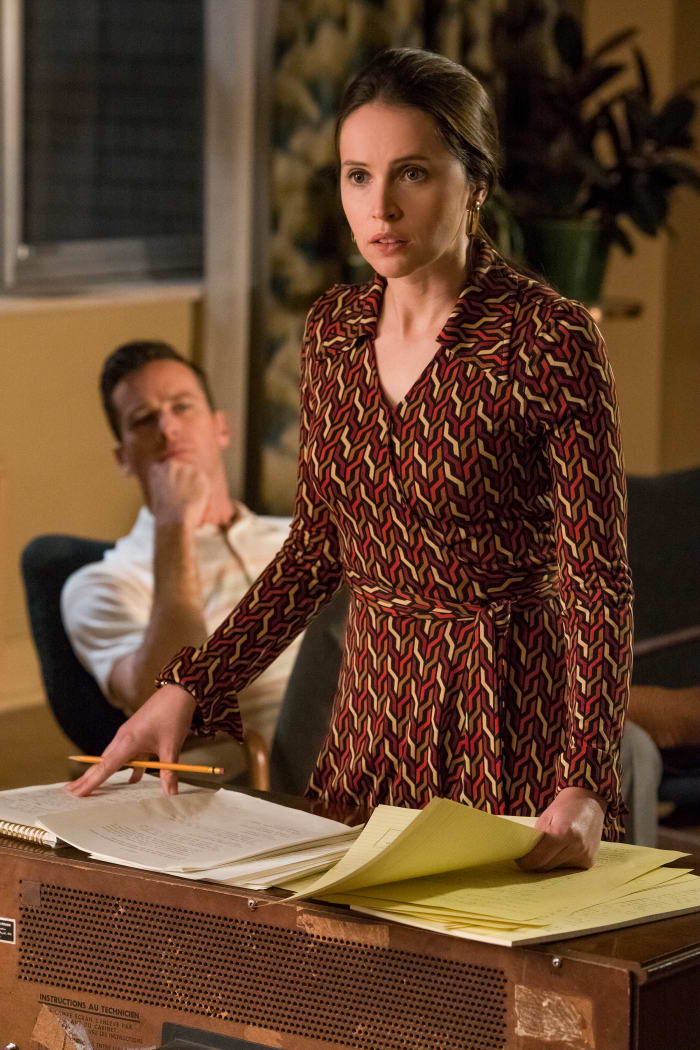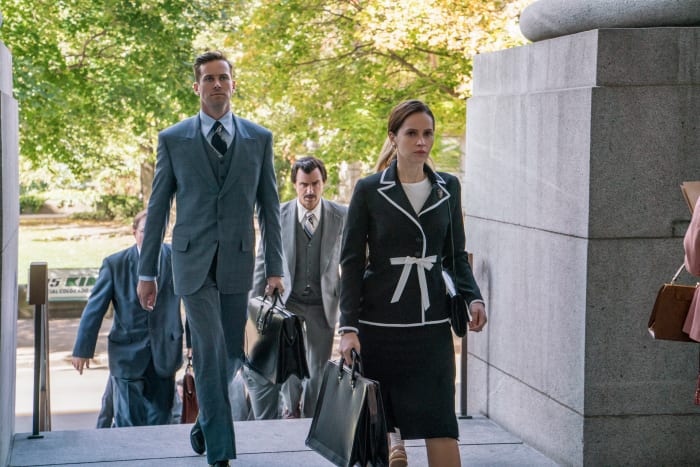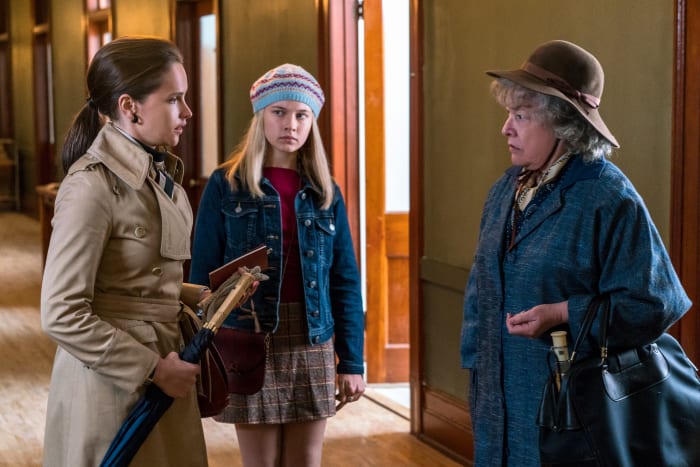“She was always stylish,” says costume designer Isis Mussenden about the real RBG.
Warning: Mild spoilers for ‘On the Basis of Sex’ below.
Ruth Bader Ginsberg is a trailblazer, role model and American hero, who made history as the second female justice on the Supreme Court of the United States. She’s a style icon, too — astutely (and chicly) accessorizing her eminent black SCOTUS robe with statement earrings, protective lace gloves and notable neckwear. Her famed silver crystal-accented “Dissent” and gold embellished “Majority Opinion” collars famously prove that fashion can be effective messaging and soft political tools. Director Mimi Leder’s RBG biopic “On the Basis of Sex,” which opens on December 25, not only depicts the landmark case that set the stage for Ginsberg’s historic SCOTUS appointment in 1993, but also the origin story of the now-Justice’s personal style.
“I learned a very lovely thing,” says the film’s costume designer Isis Mussenden, who studied imagery and documentation of Ginsberg throughout the decades to learn her approach to style and then narrow down to the ’50s and ’70s detailed in the film. “She followed the trends of fashion — appropriately — for her standing and in her own somewhat conservative way. But she was always stylish and connected to styles of the time. She had shoulder pads in ’80s and huge double breasted suits in ’90s. She had beautiful ’50s dresses and a little bit of Jackie O. in her in the early ‘70s — another iconic woman on the Upper East Side at the time.”
Along with looking through family photos from Ginsberg’s nephew and the movie’s writer, Daniel Stiepleman, Mussenden scored the holy grail of research material: a 1956 Harvard Law yearbook. ”It really told the story of Harvard [Law School at the time],” says Mussenden. The piece of history helped her introduce Ruth (Felicity Jones) in the opening scene, plus her majority white male cohorts, her few female classmates, her professors — including a very anti-Jack McCoy (Sam Waterston) — and upperclassman and devoted husband Martin “Marty” Ginsberg (Armie Hammer).
Mussenden wanted Ruth to wear a suit-type look to coordinate — and contrast — with the “very Brooks Brothers” dark suiting of the near-majority male classmates as they all excitedly walk into the Harvard auditorium. But the women’s “power suit” of the ’80s was still far on the horizon. The costume designer also wanted to establish the future Justice’s own confident sense of style which veered toward “feminine” silhouettes. ”That was a great testimony to being such an incredibly strong, strong woman — and staying feminine,” says Mussenden, who also designed the nipped-waist ’60s wardrobe in the final season of “Masters of Sex.”
So she custom-designed a cornflower blue Dior New Look-inspired fit-and-flare dress, with an intricate neckline perhaps foreshadowing the famed SCOTUS collars, and matching jacket. ”The movement of the skirt was really important to me,” says Mussenden. “I knew the camera was going to go low. There was a lot to say in the fullness of that skirt on that dress.” Blue also establishes a consistent palette and Ruth’s frequently-worn pin from her mother, which thread through the movie.
The movie jumps forward to the early ’70s in Manhattan, where Marty is a successful tax attorney and Ruth, unable to find a position at a law firm because of sexism, teaches Rutgers University in New Jersey. ”She’s a mom to two kids. She’s working. She’s teaching. She’s got a husband. She had a lot going on in an era where everybody said, ‘You should just stay home and take care of your kids,” explains Mussenden. “So her clothes reflected the simplicity of what it needed to be just to get through the day.”
Highlights of Ruth’s ’70s wardrobe include graphic, short-sleeve knit top-and-skirt sets to teach, expertly-tied silk printed scarves and a silver and pearl-embellished brocade shift dress for a soirée at Marty’s boss’s swanky apartment. When she takes on the groundbreaking tax case, which — spoiler — made discrimination on the basis of gender unconstitutional, Ruth has to prepare for her courtroom debut. Working with her childhood sleep-away camp friend and now ACLU lawyer Mel Wulf (Justin Theroux), she holds a moot court in her living room to prep — and wears a printed Diane Von Furstenberg wrap dress to further emphasize the feminist messaging.
The vintage dress, which Mussenden bought online for $80, fit the bill to both make a strong statement and feel appropriate for Ruth hosting such “distinguished” guests in her own safe space. But those with fashion history knowledge might notice an anachronism: Von Furstenberg launched her iconic wrap dress in 1974, two years after the scene would have taken place. But Mussenden is “owning it.”
“You know what a strong dress it was,” she explains. “You know how strong Diane Von Furstenberg is — as a person, as a philanthropist, as an activist. It felt so right that I just went, ‘nope, I’m using it!’ Even if the time was off.”

Ruth in a vintage DVF dress with Marty, in his signature short sleeve button-down, looking on. Photo: Jonathan Wenk/Focus Features
Mussenden looked to another legendary designer to illustrate Ruth’s entry into the courtroom to argue the landmark case. She and director Leder didn’t think a dress would be appropriate, but weren’t particularly keen on the popular suiting styles of the early ’70s, either. “They couldn’t have been uglier. They really were — honest to god — ugly, ugly, ugly, all boxy,” Mussenden laughs. So she “dug and dug and dug” into her research and came across an ivory Yves Saint Laurent skirt suit authentic to the period to recreate into the black and white-piped and ribbon-belted suit for the scene.
“She’s in the courtroom for the very first time and what do people associate with RBG?” she asks. “Her black robe and her white collar today. I wanted to connect her robes and her judicial future in that room.”
The end of the movie bookends the blue theme introduced in the beginning — starting with Jones as Ruth triumphantly walking up the courthouse steps in a custom-designed color-blocked, longline jacket-and-dress set in an authentic ’70s silhouette. But then the ultimate finale moment: the Real Ruth Bader Ginsberg walks up the steps of the United States Supreme Court.

Marty Ginsberg (Armie Hammer) and Ruth. Mussenden custom-made Harmmer’s costumes, including some ties in order to fit the 6′ 5″ actor. Photo: Jonathan Wenk / Focus Features
The open-secret cameo wasn’t confirmed until close to shooting, but Mussenden had to be prepared with looks for the Justice, just in case. Producers initially suggested a custom-made ensemble, but considering the number of fittings required, that wasn’t an option Ginsberg’s busy schedule. So Mussenden shopped a selection of contemporary pieces for the Justice to make a final decision (see what I did there?).
“I believe it’s a Tahari dress and a Max Mara jacket — so pretty,” the costume designer says, about the navy swing coat and matching dress underneath. “I had many, many other things, but I knew that was going to be it. When we looked on the rack, [Justice Ginsberg] asked me which one I thought [she should wear]. I said, ‘This dress and this jacket,’ and she goes, ‘I was thinking the same thing.'”
Mussenden provided a selection of scarves and brooches — carrying through the theme of wearing her mother’s pin — for Ginsberg to select from, too. Prior to the shoot, the costume designer also sent her a pair of vintage lace crochet gloves, which Ginsberg decided to wear for the movie.
“It was really an honor. We went into her chambers at the Supreme Court and helped her get dressed,” says Mussenden. “We gave her a little bit of makeup and we were on our way.”
Top and homepage photo: Jonathan Wenk/Focus Features
‘On the Basis of Sex’ opens in theaters on Tuesday, Dec. 25.
Never miss the latest fashion industry news. Sign up for the Fashionista daily newsletter.
Source: Fashionista


